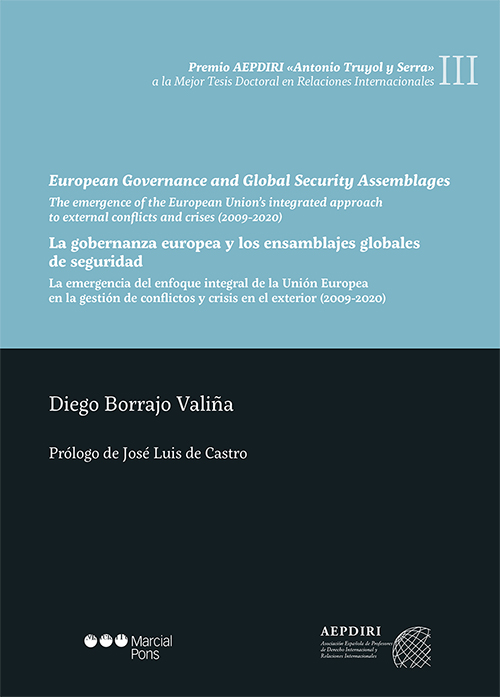European Governance and Global Security Assemblages
The emergence of the European Union´s integrated approach to external conflicts and crises (2009-2020)
- ISBN: 9788491237808
- Editorial: Marcial Pons, Ediciones Jurídicas y Sociales
- Fecha de la edición: 2020
- Lugar de la edición: Madrid. España
- Colección: Premios AEPDIRI
- Encuadernación: Rústica
- Medidas: 24 cm
- Nº Pág.: 300
- Idiomas: Español; Inglés


This book examines the emergence of the European Union's Integrated Approach to External Conflicts and Crises as one of the central concepts of the EU Global Strategy. Proposing a focus on the community of CFSP/CSDP practitioners, Diego Borrajo explores the constitution of the EU as a security provider by tracing the way the integrated approach has been progressively defined and incorporated into the EU policy documents, roadmaps and practices, shaping therefore a genuine European security governance architecture. The author argues that the history of the EU integrated approach not only provides evidence of how the EU aims to respond to conflicts and crises, shapes international structures, promotes its values and defends its interests, but also provides insights about how the EU's authoritative community of security experts and policymakers has a major impact on shaping the narratives and knowledge that inform the EU actorness in external action.
________
Este libro examina el surgimiento del enfoque integrado de la Unión Europea para los conflictos y las crisis en el exterior como uno de los conceptos centrales de la Estrategia Global. A partir de una aproximación a la comunidad de profesionales en torno a la PESC/PCSD, Diego Borrajo explora la constitución de la UE como proveedor de seguridad a partir de la forma en que se ha ido definiendo e incorporado progresivamente dicho concepto a los policy documents, roadmaps y acciones de la UE, y la manera en que ha contribuido de manera progresiva a una arquitectura de gobernanza de la seguridad propia. El autor sostiene que la historia del enfoque integral de la UE no solo aporta evidencias sobre la manera en que la UE busca gestionar los conflictos y las crisis, transformar las estructuras internacionales, promover sus valores y defender sus intereses. También permite comprender la manera en que la comunidad de expertos y policymakers en materia de seguridad contribuye a configurar las narrativas y los saberes que informan la actuación de la UE en la acción exterior.
PALABRAS PREVIAS, por Caterina García Segura
PRÓLOGO
AGRADECIMIENTOS
LIST OF ABBREVIATIONS
LISTA DE ABREVIATURAS
LIST OF FIGURES
LIST OF TABLES
INTRODUCTORY PART
CHAPTER 1
FRAMING THE RESEARCH PROJECT
1. RESEARCH OBJECTIVES
2. DEFINING THE OBJECT OF STUDY
3. PRELIMINARY CONSIDERATIONS
4. RESEARCH DESIGN. SYSTEMIC STABILITY AS THE SUPERIOR OBJECTIVE OF EU SECURITY POLICY: AN ANALYTICAL DEVICE FOR THE STUDY OF THE COMPREHENSIVE ARTICULATION OF CRISIS MANAGEMENT APPARATUS
CHAPTER 2
HYPOTHESES AND CATEGORIES OF ANALYSIS
1. HYPOTHESES
2. THE EMERGING ERA OF SOCIAL REGULATION/GOVERNMENT AND THE EU SECURITY GOVERNANCE MODEL: THE RELEVANCE OF THE STUDY
3. PLAN OF THE WORK
HISTORICAL PART
CAPÍTULO 3
MAPEANDO LAS CONDICIONES HISTÓRICAS DE LA EMERGENCIA DEL ENFOQUE INTEGRAL DE LA SEGURIDAD
1. LAS CONDICIONES HISTÓRICAS DEL DECRECIENTE PODER DEL ESTADO COMO PROVEEDOR DE SEGURIDAD
2. LAS CONDICIONES HISTÓRICAS DE LA CRECIENTE COMPLEJIDAD DE LOS FENÓMENOS DE SEGURIDAD
3. CONCLUSIONS: THE HISTORICAL CONDITIONS FOR THE EMERGENCE OF THE GOVERNMENTAL GAP BETWEEN SECURITY COMPLEXES AND THE COMPLEXITY OF THE SECURITY PHENOMENA
CAPÍTULO 4
LA RACIONALIZACIÓN ESTRATÉGICA Y OPERACIONAL DE LA UE COMO PROVEEDOR DE SEGURIDAD
1. LA INSTITUCIONALIZACIÓN DEL MODELO DE GOBERNANZA DE LA SEGURIDAD DE LA UE EN EL COMPLEJO REGIONAL DE LA SEGURIDAD
2. LA CRECIENTE DIFERENCIA ENTRE EL PODER DEL ESTADO Y LA CRECIENTE COMPLEJIDAD DE LOS FENÓMENOS SOCIALES SUSCEPTIBLES DE REGULACIÓN SECURITARIA
3. CONCLUSIONS: THE STRATEGIC RATIONALIZATION OF THE EU SECURITY POLICY AND THE EMERGENT OF THE IA
THEORETICAL PART
CHAPTER 5
AN ANALYTICAL FRAMEWORK FOR THE ANALYSIS OF THE INTEGRATED APPROACH WITHIN HE EU MODEL OF SECURITY GOVERNANCE
1. SECURITY GOVERNANCE AND THE STUDY OF THE INSTITUTIONALISATION OF SECURITY STRATEGIC FRAMEWORKS: BROADENING SECURITY ISSUES, INCREASING THE HETEROGENEITY OF ACTORS AND CONSOLIDATING RISK-BASED MANAGEMENT REGULATIVE PRINCIPLES
2. SECURITY COMMUNITIES: IDEAS AND SECURITY DISCOURSE IN INTERNATIONAL ORGANISATIONS
3. CONCLUSIONS: AN ANALYTICAL FRAMEWORK FOR THE STUDY OF THE (EPISTEMIC) IMPLICATIONS OF THE INTEGRATED APPROACH IN THE EU MODEL OF SECURITY GOVERNANCE
METHODOLOGICAL PART
CAPÍTULO 6
UN MARCO ANALÍTICO PARA EL ANÁLISIS DE LA COMUNIDAD (EPISTÉMICA) DE SEGURIDAD DE LA UE
1. OBTENCIÓN DE DATOS
2. SECURITY COMMUNITIES
3. CONCLUSIONS: AN ANALYTICAL FRAMEWORK FOR AN IDEATIONAL ANALYSIS OF EPISTEMIC COMMUNITIES
EMPIRICAL PART
CAPÍTULO 7
LA CONFIGURACIÓN ESTRATÉGICA/TECNOLÓGICA DE LA UE: DESDE LA EMERGENCIA DE LA GESTIÓN DE CRISIS A LA GOBERNANZA DE LA SEGURIDAD
1. EL MARCO TECNOLÓGICO DE LA GOBERNANZA DE LA SEGURIDAD DE LA EU: LA CONSTRUCCIÓN DE UN CONTINUUM DE GESTIÓN DE CRISIS
2. VARIACIONES DEL ENFOQUE INTEGRAL EN OTRAS ORGANIZACIONES: ENTRE LA MODULACIÓN SISTÉMICA Y LA IMPLICACIÓN DE TERCEROS
3. CONCLUSIONS. THE PRESENT STRATEGIC FRAMEWORK OF THE EU TRANSFORMATIVE POWER: THE REGULATIVE PRINCIPLES AND TECHNOLOGICAL APPARATUS OF THE EU SECURITY GOVERNANCE MODEL
CAPÍTULO 8
VARIACIONES EPISTÉMICAS EN LA COMUNIDAD DE SEGURIDAD DE LA UE: EL ENFOQUE INTEGRAL
1. LA EXPANSIÓN DE LA SEGURIDAD Y LA CRECIENTE INTELIGIBILIDAD DE LAS CRISIS INTERNACIONALES
2. HACIA LA REDISTRIBUCIÓN DE LA RESPONSABILIDAD EN LOS MARCOS DE REGULACIÓN DE LA SEGURIDAD: ACCIONES DE CAPACITY-BUILDING Y RESILIENCIA
3. CONCLUSIONS: EMERGING DISCURSIVE STRATEGIES AND THE INTEGRATED APPROACH ON THE TRANSFORMATION OF THE EU SECURITY GOVERNANCE MODEL
4. DISCUSIÓN DE LOS RESULTADOS
CONCLUDING PART
CHAPTER 9
CONCLUSIONS
1. THE CONDITIONS FOR THE EMERGENCE OF THE INTEGRATED APPROACH
2. EU INTEGRATED APPROACH
3. HYPOTHESES
ANEXO
RESUMEN DE LA TESIS
1. EL OBJETO DE ESTUDIO Y LOS OBJETIVOS DE LA INVESTIGACIÓN
2. HIPÓTESIS
3. METODOLOGÍA
4. PLAN DE LA OBRA
5. CONCLUSIONES
REFERENCES
Premio AEPDIRI «Antonio Truyol y Serra» a la Mejor Tesis Doctoral en Relaciones Internacionales.
Prólogo de José Luis de Castro.







